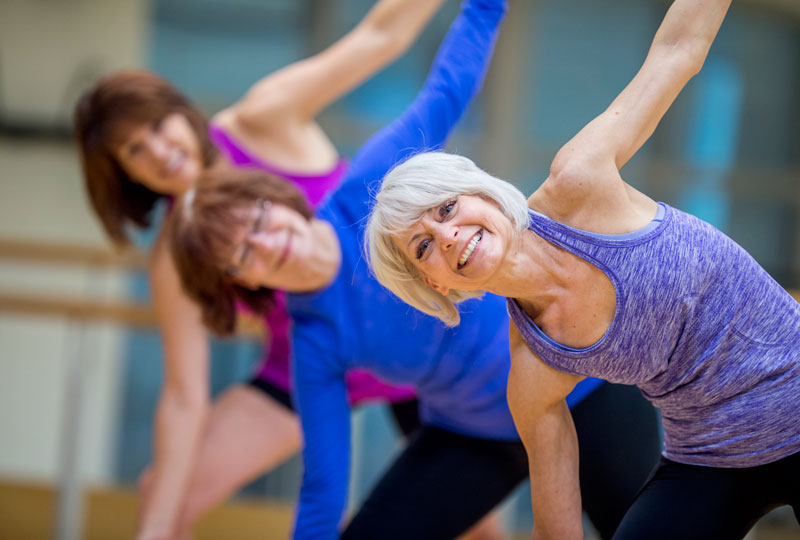My Darlings, please enjoy this wonderful article by Paula Marie Usrey. Paula founded Boomer Best U to promote positive aging and to fight age discrimination. In this article, she speaks about how it’s never too late for a new approach in life. I think it goes quite nicely with our January theme of REINVENTION! Enjoy.

Pic by Saga
It’s Not Too Late for a New Approach
I was a chubby child and have struggled with weight management throughout my life. When I was younger, I endured a lot of teasing and embarrassment because I was visibly overweight. Then I learned that by carefully watching what I ate and by maintaining a regular exercise schedule, I could generally keep my weight under control—at least for a period of several years.
Even when I did gain extra pounds, I knew I could lose some of my excess weight by dieting and increased exercise. Then I hit my fifties and menopause. I worked out more and tried all kinds of diets, but with little success. Like many other women, I had discovered that weight management can be more difficult after menopause. I also learned that I was putting myself at risk for increased health problems because of some excess fat that was starting to accumulate around my middle.
So, I needed a new approach.
I Didn’t Think My Doctor Heard Me
When I was in my mid-fifties, I complained to my trim, younger doctor that I was doing everything possible to lose weight but to no avail. I explained to her that I even jogged over 20 miles each week and also did strength training. I was hoping she would prescribe diet pills or at least express some degree of empathy. Instead, she rather flatly asked if I had tried interval training. She briefly told me that interval training involved bursts of high-intensity exercise followed by short intervals of less intensity.
I wondered if my doctor had even heard me when I told her how much exercise I was doing or how hard I was trying to manage my weight. I believed something was clearly wrong with me, and I felt like I needed help—not exercise advice.
Instead of following her recommendation, I found a different doctor. My new doctor prescribed thyroid pills, which helped to some degree. However, I was still working very hard at what I felt like was a losing battle.

pic by daily express
A New Approach
Last month I turned 68. For the past year, I’ve maintained a habit of jogging and/or walking 30-35 miles each week. Up until a couple of months ago, I felt like I’d tried everything (including various diets and fasting routines), but nothing was going to help me manage my weight.
I happened to see an article on high-intensity interval training (HIIT) for adults over 50. The article explained what my former doctor probably didn’t have time to tell me during a short office visit: Interval training was an effective way not only to burn calories more efficiently but to build muscles as well. In addition, it potentially offered other health benefits that I hadn’t thought about when I was in my fifties.
The Basics
According to a Silver Sneakers article, HITT involves short but intense periods of activity with brief, alternating recovery periods. Typically, HIIT workouts are often only 30 minutes (or slightly more) and can be incorporated into almost any type of exercise routine.
An article posted on the PrimeWomen site suggested a gradual approach to beginning HIIT training, especially for those who are re-engaging in an exercise program. For example, women who like to walk could start HIIT training by strolling for a few minutes to warm up, then increase their intensity for about 20 seconds, and then slow down for up to 90 seconds. The article recommends repeating this pattern four times. For those who like to jog, this article suggests gradually working up to 3-minute higher intensity bursts followed by walking or a reduced activity level.
Other Potential Health Benefits
As reported in Aaptiv, an online fitness magazine for older adults, a Denmark study “found that participants who did 12 weeks of HIIT training had more controlled glucose (or blood sugar) levels.” In this same article, HITT training was also reported to improve lung functioning, overall aerobic capacity, and memory.
An AARP article explained how and why high-intensity interval training is beneficial by reducing the effects of aging at a cellular level. In one study, participants over sixty-five had a 69 percent cellular increase in the ability to “take in oxygen and produce energy.”
Jennifer J. Heisz is an associate professor of kinesiology at McMaster University and directs research at the NeuroFit Lab. She reported that older adults who participated in high-intensity interval training for 12 weeks experienced improved memories. Heisz said the “memory gains were directly related to their improvements in physical fitness.”
Common Sense Precautions
Health experts advise getting a health check-up before starting an intense exercise routine. This could be especially true for women “when it comes to cardiac and pulmonary health.” Also, starting slowly and building muscle strength and capacity is safer than trying to do too much too fast. A personal trainer sharing insights for Silver Sneakers suggested paying attention to your body when starting a new program rather than pushing too hard. “Common injuries include torn ligaments, swollen muscles, and even slipped discs.”
Some articles suggest working with a personal trainer to build strength and flexibility before starting a HIIT routine. A couple of other articles I reviewed suggested limiting HIIT routines to 3 or 4 times a week.

My HIIT Test-Drive
Two days after Thanksgiving, I was ready to try high-intensity interval training. I had already made sure my health checked out before trying to push myself more when exercising. The first time I tried a brief stint of high-intensity activity was while jogging. I identified a road sign as my goal and moved as fast and hard as I could to reach that sign. I don’t think my ‘burst’ lasted for more than 20 or 30 seconds. But by the time I reached my target road sign, I was out of breath and wondered what in the world I was doing. I walked until I caught my breath and then tried again. Over the past few weeks, I have been able to increase my high-intensity periods and have needed less recovery time in-between.
Yesterday, I incorporated HIIT while riding my bicycle. I’m feeling stronger and my clothes are already fitting better. I don’t know if high-intensity interval training is right for everyone. But for me, it feels right. I am feeling encouraged and plan to make my HIIT routine part of my life for the foreseeable future.
Have you tried HIIT workouts? I would love to hear from you in the comments.
 Paula Marie Usrey founded Boomer Best U to help promote positive aging and fight age discrimination. She has also given a TEDx presentation on how to live your best life at any age. Paula recently retired as an Associate Professor of Communication from Umpqua Community College.
Paula Marie Usrey founded Boomer Best U to help promote positive aging and fight age discrimination. She has also given a TEDx presentation on how to live your best life at any age. Paula recently retired as an Associate Professor of Communication from Umpqua Community College.
A lot of important points in this article that we should know. This would somehow be a huge help. Thanks for sharing this great article.
I am so glad you enjoyed and learned. Thank you for letting me know. Warmly, Honey
These are really great routines. I hope I can try this out.